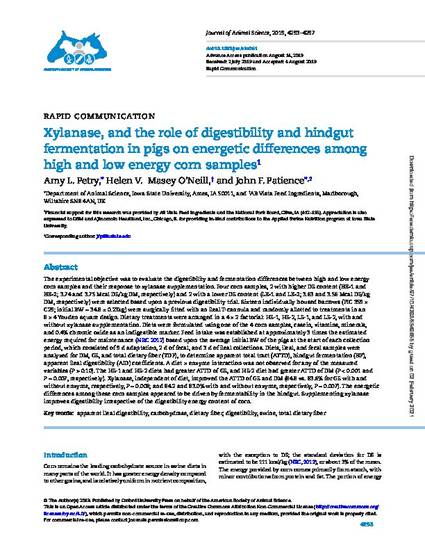
The experimental objective was to evaluate the digestibility and fermentation differences between high and low energy corn samples and their response to xylanase supplementation. Four corn samples, 2 with higher DE content (HE-1 and HE-2; 3.74 and 3.75 Mcal DE/kg DM, respectively) and 2 with a lower DE content (LE-1 and LE-2; 3.63 and 3.56 Mcal DE/kg DM, respectively) were selected based upon a previous digestibility trial. Sixteen individually housed barrows (PIC 359 × C29; initial BW = 34.8 ± 0.23kg) were surgically fitted with an ileal T-cannula and randomly allotted to treatments in an 8 × 4 Youden square design. Dietary treatments were arranged in a 4 × 2 factorial: HE-1, HE-2, LE-1, and LE-2, with and without xylanase supplementation. Diets were formulated using one of the 4 corn samples, casein, vitamins, minerals, and 0.4% chromic oxide as an indigestible marker. Feed intake was established at approximately 3 times the estimated energy required for maintenance (NRC 2012) based upon the average initial BW of the pigs at the start of each collection period, which consisted of 9 d adaptation, 2 d of fecal, and 3 d of ileal collections. Diets, ileal, and fecal samples were analyzed for DM, GE, and total dietary fiber (TDF), to determine apparent total tract (ATTD), hindgut fermentation (HF), apparent ileal digestibility (AID) coefficients. A diet × enzyme interaction was not observed for any of the measured variables (P > 0.10). The HE-1 and HE-2 diets had greater ATTD of GE, and HE-2 diet had greater ATTD of DM (P < 0.001 and P = 0.007, respectively). Xylanase, independent of diet, improved the ATTD of GE and DM (84.8 vs. 83.6% for GE with and without enzyme, respectively, P = 0.008; and 84.2 and 83.0% with and without enzyme, respectively, P = 0.007). The energetic differences among these corn samples appeared to be driven by fermentability in the hindgut. Supplementing xylanase improves digestibility irrespective of the digestibility energy content of corn.
Available at: http://works.bepress.com/john-patience/77/

This article is published as Petry, Amy L., Helen V. Masey O’Neill, and John F. Patience. "Xylanase, and the role of digestibility and hindgut fermentation in pigs on energetic differences among high and low energy corn samples." Journal of animal science 97, no. 10 (2019): 4293-4297. doi: 10.1093/jas/skz261.